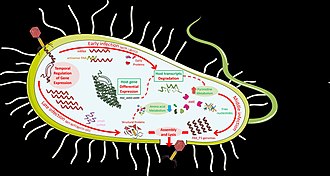Myoviridae
Myoviridae is a family of bacteriophages characterized by their long, contractile tails, which are used to inject the phage DNA into the host bacteria. This family is part of the order Caudovirales, which encompasses viruses with tail structures. Myoviridae phages are among the most complex bacteriophages and play a significant role in bacterial population dynamics, horizontal gene transfer, and the development of bacterial pathogenicity.
Classification
The Myoviridae family is divided into several genera and species, based on their genetic material, morphology, and lifecycle. The classification of Myoviridae has evolved over time with advances in molecular biology techniques, leading to a more detailed understanding of their phylogenetic relationships.
Morphology
Myoviridae phages possess a distinctive morphology, featuring an icosahedral capsid and a long, contractile tail. The tail is a complex structure made of several proteins that contract upon contact with a susceptible host, piercing the bacterial cell wall and allowing the phage to inject its DNA into the host cell. The tail structure is not only crucial for the infection process but also serves as a key identifying feature of Myoviridae phages.
Lifecycle
The lifecycle of Myoviridae can follow either the lysogenic cycle or the lytic cycle. In the lysogenic cycle, the phage DNA integrates into the host genome, becoming a prophage, and replicates along with the host cell without causing immediate harm. Conversely, in the lytic cycle, the phage takes over the host's cellular machinery to produce new phage particles, eventually leading to the lysis of the host cell and the release of progeny phages.
Ecological and Medical Significance
Myoviridae phages play a crucial role in regulating bacterial populations in various environments, contributing to the microbial balance in aquatic and terrestrial ecosystems. They are also involved in the transfer of genes among bacteria, including those responsible for antibiotic resistance and virulence factors, impacting the evolution of bacterial pathogenicity.
In the medical field, Myoviridae phages are being explored as alternatives to antibiotics in the treatment of bacterial infections, especially those resistant to multiple drugs. Phage therapy, which utilizes bacteriophages to target and kill pathogenic bacteria, offers a promising approach to combating antibiotic-resistant infections.
Research and Applications
Research on Myoviridae has led to significant advancements in understanding bacteriophage biology, including their mechanisms of infection, replication, and interaction with host bacteria. These insights have applications in biotechnology, such as the development of phage-based tools for bacterial detection and control, and in the design of novel therapeutic strategies against bacterial infections.
See Also
Transform your life with W8MD's budget GLP-1 injections from $125.
W8MD offers a medical weight loss program to lose weight in Philadelphia. Our physician-supervised medical weight loss provides:
- Most insurances accepted or discounted self-pay rates. We will obtain insurance prior authorizations if needed.
- Generic GLP1 weight loss injections from $125 for the starting dose.
- Also offer prescription weight loss medications including Phentermine, Qsymia, Diethylpropion, Contrave etc.
NYC weight loss doctor appointments
Start your NYC weight loss journey today at our NYC medical weight loss and Philadelphia medical weight loss clinics.
- Call 718-946-5500 to lose weight in NYC or for medical weight loss in Philadelphia 215-676-2334.
- Tags:NYC medical weight loss, Philadelphia lose weight Zepbound NYC, Budget GLP1 weight loss injections, Wegovy Philadelphia, Wegovy NYC, Philadelphia medical weight loss, Brookly weight loss and Wegovy NYC
|
WikiMD's Wellness Encyclopedia |
| Let Food Be Thy Medicine Medicine Thy Food - Hippocrates |
Medical Disclaimer: WikiMD is not a substitute for professional medical advice. The information on WikiMD is provided as an information resource only, may be incorrect, outdated or misleading, and is not to be used or relied on for any diagnostic or treatment purposes. Please consult your health care provider before making any healthcare decisions or for guidance about a specific medical condition. WikiMD expressly disclaims responsibility, and shall have no liability, for any damages, loss, injury, or liability whatsoever suffered as a result of your reliance on the information contained in this site. By visiting this site you agree to the foregoing terms and conditions, which may from time to time be changed or supplemented by WikiMD. If you do not agree to the foregoing terms and conditions, you should not enter or use this site. See full disclaimer.
Credits:Most images are courtesy of Wikimedia commons, and templates, categories Wikipedia, licensed under CC BY SA or similar.
Contributors: Prab R. Tumpati, MD



